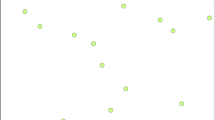Abstract
Data acquisition in a wireless sensor network typically involves routing data from numerous sensors toward a static sink or a base station. To achieve this efficiently, mobile sink strategies have been investigated by numerous researchers. However, a thorough qualitative study of the mobile sink path has mostly been disregarded in the literature. As such no strong common qualitative measurement can be asserted regarding a particular technique against the others. This paper proposes a new technique based on the space filling curve which produces a mobile sink path for an arbitrarily network shape. Furthermore, we refine this technique such that a path can cover the network of different granularity. Finally we also propose a common path quality measurement which can be used to compare path qualities between various techniques.






Similar content being viewed by others
References
Bruck J, Gao J, Jiang A (2005) Localization and routing in sensor networks by local angle information. In: MobiHoc ’05: Proceedings of the 6th ACM international symposium on mobile ad hoc networking and computing. ACM, New York, pp 181–192
Chatterjea S, Nieberg T, Meratnia N, Havinga P (2008) A distributed and self-organizing scheduling algorithm for energy-efficient data aggregation in wireless sensor networks. ACM Trans Sens Netw 4(4):1–41
Chatzigiannakis I, Kinalis A, Nikoletseas S (2006) Sink mobility protocols for data collection in wireless sensor networks. In: MobiWac ’06: Proceedings of the international workshop on Mobility management and wireless access. ACM Press, New York, pp 52–59
Chhieng VM, Choi RH, Wong RK (2007) Efficient geometric routing in ad-hoc wireless networks. In: CCNC ’07: consumer communications and networking conference, pp 259–263
Chhieng VM, Wong RK, Fong S (2012) Data acquisition in sensor network using an autonomous path. International conference on connected vehicles and expo (ICCVE), pp 179–184
Fang Q, Gao J, Guibas LJ (2004) Locating and bypassing routing holes in sensor networks. In: INFOCOM, 23rd annual joint conference of the IEEE computer and communications societies. IEEE, Hong Kong
Hsu AC (1990) The expected distance between two random points in a polygon. Master’s thesis, Massachusetts Institute of Technology Department of Civil Engineering
Jain S, Shah RC, Brunette W, Borriello G, Roy S (2006) Exploiting mobility for energy efficient data collection in wireless sensor networks. Mobile Netw Appl 11(3):327–339
Johnson DB, Maltz DA (1996) Dynamic source routing in ad hoc wireless networks. In: Imielinski, Korth (eds) MobiCom ’96: Proceedings of the 2th annual ACM/IEEE international conference on mobile computing and networking, vol 353. Kluwer Academic Publishers, Dordrecht
Kahn JM, Katz RH, Pister KSJ (1999) Next century challenges: mobile networking for Smart Dust. In: MobiCom ’99: Proceedings of the 5th annual ACM/IEEE international conference on mobile computing and networking. ACM Press, New York, pp 271–278
Kuhn F, Wattenhofer R, Zhang Y, Zollinger A (2003) Geometric ad-hoc routing: of theory and practice. In: PODC ’03: Proceedings of the twenty-second annual symposium on principles of distributed computing. ACM Press, New York, pp 63–72
Li J, Jannotti J, De Couto DSJ, Karger DR, Morris R (2000) A scalable location service for geographic ad hoc routing. In: MobiCom ’00: Proceedings of the 6th annual international conference on mobile computing and networking. ACM Press, New York, pp 120–130
Luo J, Hubaux J-P (2005) Joint mobility and routing for lifetime elongation in wireless sensor networks. In: INFOCOM 2005: 24th annual joint conference of the IEEE computer and communications societies, Miami, pp 1735–1746
Nakamura EF, Loureiro AAF, Frery AC (2007) Information fusion for wireless sensor networks: methods, models, and classifications. ACM Comput Surv 39(3):9
Pompili D, Melodia T, Akyildiz IF (2006) Routing algorithms for delay-insensitive and delay-sensitive applications in underwater sensor networks. In: MobiCom ’06: Proceedings of the 12th annual international conference on mobile computing and networking. ACM Press, New York, pp 298–309
Ratnasamy S, Karp B, Yin L, Yu F, Estrin D, Govindan R, Shenker S (2002) GHT: a geographic hash table for data-centric storage. In: WSNA ’02: Proceedings of the 1st ACM international workshop on wireless sensor networks and applications. ACM Press, New York, pp 78–87
Rawat P, Singh KD, Chaouchi H, Jean-Marie B (2014) Wireless sensor networks: a survey on recent developments and potential synergies. J Supercomput 68(1):1–48
Ruina A, Pratap R (2002) Introduction to statics and dynamics (pre release text). Oxford University Press, Oxford
Salas S, Hille E (1995) Calculus, one and several variables, 7th edn. Wiley, New York
Vincze Z, Vass D, Vida R, Vidács A, Telcs A (2006) Adaptive sink mobility in event-driven multi-hop wireless sensor networks. In: InterSense ’06: Proceedings of the first international conference on integrated internet ad hoc and sensor networks. ACM Press, New York, p 13
Wang ZM, Basagni S (2005) Emanuel Melachrinoudis, and Chiara Petrioli. Exploiting sink mobility for maximizing sensor networks lifetime. In: HICSS ’05: Proceedings of the 38th annual Hawaii international conference on system sciences (HICSS’05)—Track 9. IEEE Computer Society, Washington, DC, p 287.1
Wang W, Srinivasan V, Chua K-C (2005) Using mobile relays to prolong the lifetime of wireless sensor networks. In: MobiCom ’05: Proceedings of the 11th annual international conference on mobile computing and networking. ACM Press, New York, pp 270–283
Weisstein EW, Hilbert curve. From MathWorld—a Wolfram Web Resource. http://mathworld.wolfram.com/HilbertCurve.html
Wu Y, Zhang L, Wu Y, Niu Z (2006) Interest dissemination with directional antennas for wireless sensor networks with mobile sinks. In: SenSys ’06: Proceedings of the 4th international conference on embedded networked sensor systems. ACM Press, New York, pp 99–111
Author information
Authors and Affiliations
Corresponding author
Rights and permissions
About this article
Cite this article
Chhieng, V.M., Wong, R.K., Fong, S. et al. Autonomous path based data acquisition in sensor networks. J Supercomput 72, 4021–4042 (2016). https://doi.org/10.1007/s11227-016-1745-4
Published:
Issue Date:
DOI: https://doi.org/10.1007/s11227-016-1745-4




